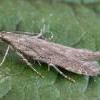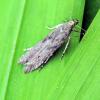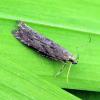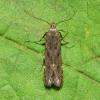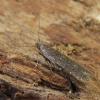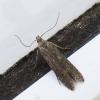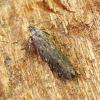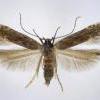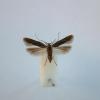35.077 Monochroa hornigi (Staudinger, 1883)
Status and Distribution
Very local but possibly over-looked due to its retiring habits. A moth of south and south east England which has, in more recent times (1995, 1996 and 2011) been discovered as far north as Yorkshire.

Provisional map
Foodplant and Larval Feeding Signs
Persicaria sp.
In Europe found on Persicaria lapathifolia (pale persicaria), Persicaria hydropiper (water-pepper), Polygonum aviculare (knotgrasses) and may possibly utilise Rumex species.
There are no external signs of feeding damage.
Habitat
Light trapped specimens have come from a variety of habitats including gardens, parks and damp areas, while larvae (two bred) were found on only a single occasion in dead Persicaria sp. stems in and near a damp roadside ditch. The foodplant genus (Persicaria) is found on disturbed ground such as on the edge of cultivated fields, and the open margins of lakes, ponds, streams and rivers, and also on waste ground.
Finding the Moth
Larva: feeding period probably from September though to April. Likely stems of the foodplant should be noted during the flowering season and revisited from late November onwards. They can be overwintered outside and the larva will vacate the stems in mild conditions in April to pupate elsewhere.
Adult: sweeping in suitable habitat amongst the foodplants may be worthwhile but most records have been at light.
Similar Species
The forewing of Monochroa conspersella can be faintly purplish-tinged, sometimes has a pale oblique mark on the costa at three-quarters and has a sprinkling of paler scales throughout, but is otherwise quite similar to Monochroa hornigi.
M. elongella has white rings on the antenna and an ochreous-yellow base to the abdomen; this area is fuscous in M. hornigi and M. conspersella.
M. moyses has grey forewings with a paler base to the scales and fuscous only towards the apex, has tibial shanks without pale marks and has a wingspan of 8-9mm. In M. hornigi the forewing colour is brownish fuscous, there is a pale band at the tip of the hind tibia and it is larger with a wingspan of 9-11.5mm.
If even slightly worn there could be confusion with other species and dissection is therefore recommended if there is any doubt at all.
Single brooded, from mid-June to mid-August.
Ealiest: 5th June 1997 (VC19)
Latest: 21st August 1995 (VC63)

